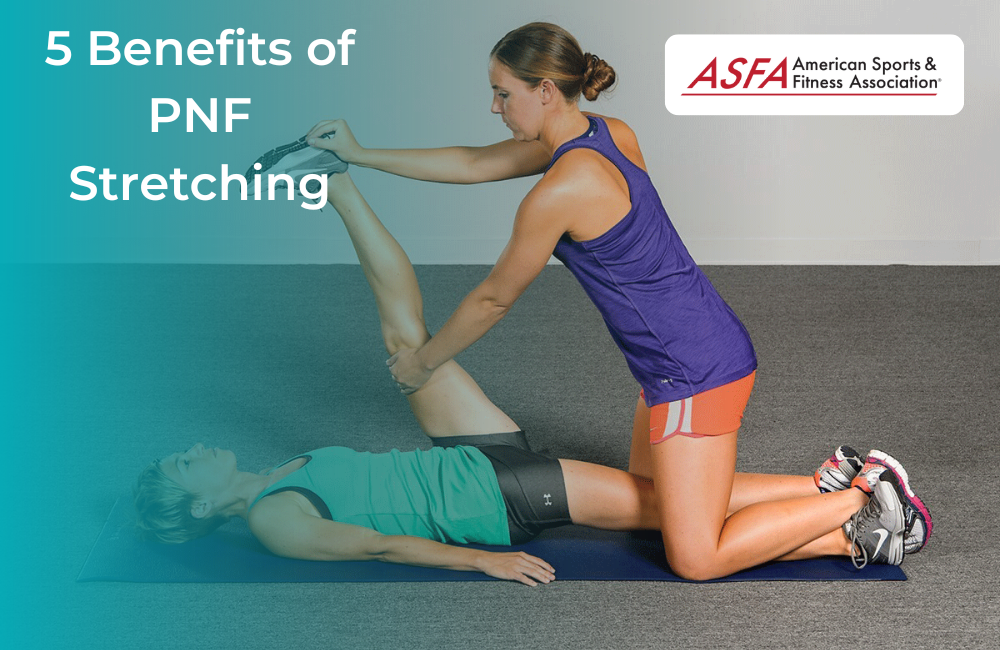Proprioceptive neuromuscular facilitation stretching (PNF stretching) is a proven flexibility training technique gaining widespread popularity among athletes, fitness enthusiasts, and trainers. Originating in the 1940s to aid in rehabilitation, PNF stretching combines muscle contractions and relaxation techniques to enhance flexibility and range of motion. The American Sports and Fitness Association (ASFA) endorses this method, recognizing its numerous benefits in supporting athletic performance, injury prevention, and overall well-being. Here’s an in-depth look at the top five benefits of PNF stretching and why it should be a part of your fitness routine.
What is Proprioceptive Neuromuscular Facilitation (PNF) Stretching?
Proprioceptive Neuromuscular Facilitation (PNF) stretching is a sophisticated technique designed to enhance muscle flexibility and range of motion. Unlike traditional static stretching, PNF stretching involves a combination of passive stretching and isometric muscle contractions. This method targets specific muscle groups, making it ideal for those recovering from an injury, aiming to boost performance, or seeking to increase their range of motion.
The technique leverages the inverse myotatic reflex, also known as the Golgi tendon reflex, to achieve deeper muscle relaxation. By alternating between contracting and relaxing the muscles, PNF stretching helps to realign muscle fibers and improve overall muscle flexibility. This unique approach goes beyond the capabilities of static stretching, offering a more effective way to enhance flexibility and support muscle recovery.
1. Improved Flexibility and Range of Motion
Greater Muscle Length and Elasticity
PNF stretching is known for significantly enhancing flexibility and expanding range of motion, allowing muscles to extend and contract more effectively. PNF techniques help realign muscle fibers and restore connective tissue after micro-damage sustained during intense workouts. By engaging in an active contraction before stretching, the muscle fibers elongate and improve their overall elasticity. This increased length of the muscle-tendon unit facilitates better movement and flexibility, which is essential for activities requiring high flexibility, like gymnastics, dance, and martial arts.
Stretch Techniques for Optimal Results
The technique involves a “contract-relax” method, where a passive stretch is applied to a muscle before you contract it isometrically against resistance, relax, and then stretch it again. The repeated cycle deepens the stretch each time, resulting in more noticeable gains in flexibility than static stretching alone.
Benefits in Action:
-
Enhanced Mobility: Makes everyday movements, such as bending, reaching, and lifting, more fluid and effortless.
-
Efficient Muscle Activation: Reduces muscle tension and improves movement fluidity, making workouts and athletic performances more effective.
2. Reduced Risk of Injury
Better Joint Stability and Muscle Balance
One of the primary functions of PNF stretching is to support muscle and joint stability, which can be instrumental in reducing the risk of injuries. Flexible muscles are more resilient under pressure and can better absorb impact, decreasing the likelihood of strains, sprains, and other injuries. Furthermore, PNF stretching addresses muscle imbalances, which often lead to injury due to uneven stress on the body.
Injury Prevention Techniques
PNF stretches are often performed with a partner or trainer who can apply consistent pressure, helping you achieve a controlled and deeper stretch. The isometric contraction phase also reinforces muscular strength, while the stretching phase enhances flexibility, creating a balanced approach that fosters injury resistance.
Benefits in Action:
-
Joint Protection: Reduces wear and tear on joints, particularly in sports that require repetitive movements, such as running or cycling.
-
Muscle Equilibrium: Corrects muscle imbalances, promoting a well-aligned posture and protecting against injuries caused by asymmetrical movements.
3. Enhanced Athletic Performance
Improved Power, Speed, and Agility
Flexibility is a key factor in improving athletic performance, allowing muscles to move efficiently through a larger range of motion. PNF stretching enables athletes to perform optimally by enhancing their ability to generate power, speed, and agility. By stretching and contracting the target muscle, PNF stretching enhances muscle elasticity and overall performance. As muscles become more flexible and joints more mobile, athletes can make faster, stronger, and more precise movements. This benefit is particularly valuable in sports that demand flexibility and control, such as martial arts, soccer, and gymnastics.
Benefits for Different Sports
Increased flexibility also optimizes muscle function, making it easier for athletes to achieve their full potential. For example, a sprinter with enhanced hamstring flexibility can lengthen their stride, while a weightlifter with shoulder mobility can perform lifts more safely and effectively.
Benefits in Action:
-
Faster Reaction Times: Improves reflexes, especially in sports requiring sudden shifts in movement or position.
-
Optimal Muscle Function: Reduces fatigue during prolonged physical activity, enabling athletes to maintain peak performance.
How PNF Stretching Improves Muscle Strength and Endurance
Incorporating PNF stretching into your fitness routine can significantly improve muscle strength and endurance. This stretching technique not only increases the length of the muscle but also enhances neuromuscular efficiency. When performed correctly, PNF stretching can help strengthen muscle groups and improve overall performance.
Studies have shown that athletes who incorporate PNF stretching into their regular routines experience notable improvements in activities such as jogging, vertical jumping, and throwing distance. For instance, a study found that athletes who performed PNF stretching twice a week for eight weeks saw more than double the improvement in their vertical jump and throwing distance compared to those who did not. This demonstrates the powerful impact of PNF stretching on muscle strength and endurance, particularly in the hamstring and lower leg (gastrocnemius) muscles.
4. Improved Posture and Alignment
Correcting Muscle Imbalances and Realigning Muscle Fibers for Better Posture
PNF stretching is an effective tool for correcting postural issues, as it balances out muscle groups by stretching tight muscles and activating weaker ones. Poor posture can result from muscular imbalances, often caused by repetitive motions, prolonged sitting, or inadequate stretching. By enhancing flexibility in tight areas and activating underutilized muscles, PNF stretching helps align the musculoskeletal system, resulting in better posture.
Techniques for Postural Correction
When performed consistently, PNF stretching alleviates tightness in overactive muscles (such as the hip flexors in desk workers) and strengthens underactive muscles (like the glutes), which can help correct posture over time.
Benefits in Action:
-
Reduced Back and Neck Pain: Decreases stress on the spine by realigning the body, minimizing strain on areas prone to discomfort.
-
Improved Movement Mechanics: Enhances everyday movement patterns, making lifting, walking, and other activities feel more natural and less strenuous.
5. Increased Relaxation and Stress Relief
Mental and Physical Relaxation
PNF stretching is as beneficial for the mind as it is for the body. The rhythmic contractions and relaxation phases help relieve tension, allowing the body to release stored stress. This practice, combined with a focus on breathing, creates a calming effect that promotes relaxation and overall mental well-being. The mind-body connection fostered during PNF stretching can be particularly helpful for athletes under pressure and individuals managing daily stress.
Techniques for Enhancing Relaxation
By focusing on controlled breathing during the stretch, individuals can deepen their relaxation. The act of releasing muscle tension through stretching signals to the nervous system that the body is safe and can relax, which is a critical aspect of stress relief.
Benefits in Action:
-
Mind-Body Connection: Encourages a greater awareness of body movements, promoting mindfulness and present-focused awareness.
-
Better Sleep Quality: Reduces muscle and joint tension, leading to a more restful and uninterrupted sleep cycle.
Safety Precautions and Guidelines for PNF Stretching
While PNF stretching is highly effective, it’s essential to approach it with caution to avoid injury. PNF stretching involves specific techniques that require proper guidance, making it advisable to perform these stretches with a knowledgeable partner or under the supervision of a trained professional.
One of the key safety precautions is to avoid stretching unstable joints, such as the shoulders, to prevent potential injuries. Additionally, PNF stretching can temporarily decrease muscular performance in activities that require maximal muscle effort, such as plyometrics, sprinting, weightlifting, and high-intensity training. Therefore, it’s important to time your PNF stretching sessions appropriately within your training schedule.
For novice stretchers, attempting PNF stretching without proper guidance can lead to muscle tears and other injuries. To perform PNF stretching safely, follow these guidelines:
-
Always warm up before stretching.
-
Use a partner who understands the technique.
-
Avoid overstretching and listen to your body.
-
Seek guidance from a certified trainer to ensure proper form and technique.
By adhering to these safety precautions and guidelines, you can effectively incorporate PNF stretching into your routine while minimizing the risk of injury.
Making the Most of Proprioceptive Neuromuscular Facilitation with Professional Guidance
Seeking Certified Guidance for Optimal Results
PNF stretching can be complex, and having guidance from a qualified trainer is crucial to ensure proper technique and avoid overstretching. Trainers certified through organizations like the ASFA can tailor PNF stretching routines to your specific needs, helping you achieve safe and effective results. For fitness professionals, ASFA offers certifications that enhance your knowledge and ability to teach clients this beneficial technique.
Conclusion
Proprioceptive Neuromuscular Facilitation (PNF) stretching is an exceptional tool for boosting flexibility, enhancing athletic performance, and promoting both physical and mental well-being. Whether you’re an athlete, a fitness enthusiast, or someone looking to improve everyday mobility, incorporating PNF stretching into your routine offers numerous benefits. With the support of a certified trainer, you can maximize the advantages of this technique, unlocking greater flexibility, reducing the risk of injury, and improving your overall quality of life. Embrace PNF stretching today to enhance your movement, posture, and relaxation for a well-rounded approach to fitness.





